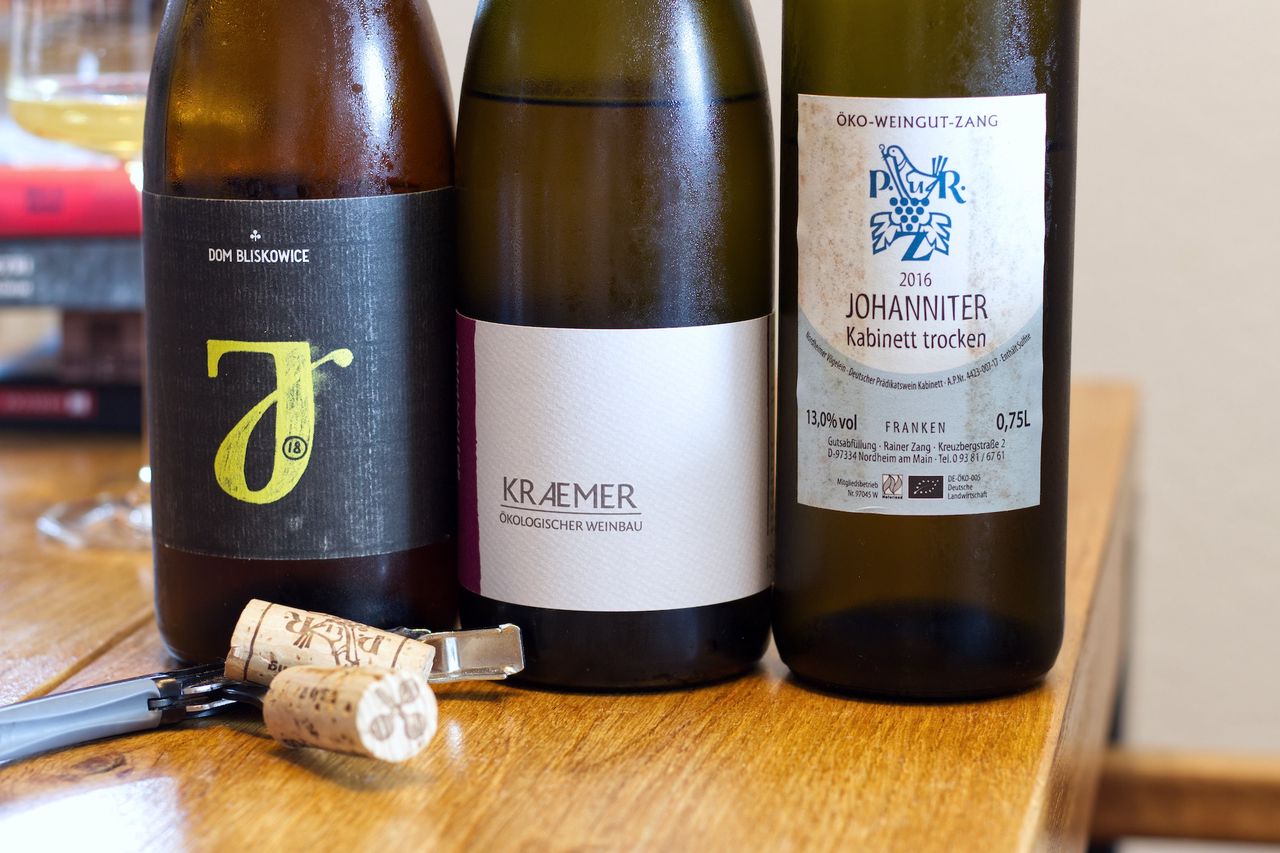Three Bottles Johanniter
It continues with PiWis. We drink three different Johanniter: Kabinett 2016 from Weingut Zang, J 2018 from Dom Bliskowice and Steillage Muschelkalk 2017 from Weinbau Kraemer.

Johanniter, at least in german, actually sounds more like accident assistance or a monastery than a grape variety to me. Whether they did themselves a big favor with the name is therefore open to question. To be fair, the bar for PiWi grape variety names is not particularly high either. Yes, I’m looking in your direction Monarch, Solaris, Muscaris or Cabernet Cortis. Whatever. We continue to try our way through the world of fungus-resistant varieties and have three completely different Johanniter in the glass for this purpose. On the one hand, this is good because it shows the range, but on the other hand, it is bad if you want to find out what a typical Johanniter actually tastes like. So we don’t even try that and concentrate on the aspect of variety in the range. And while we’re on the subject of variety, the list of wine countries in our personal atlas is going to be extended by one entry.
I don’t remember ever drinking wine from Poland or even thinking about whether there is wine growing in Poland at all. In fact, there has been viticulture in Poland for over a thousand years. However, the current area of vines is tiny at around 500 hectares. The Dom Bliskowice winery makes Natural wines between Warsaw and Krakow. It was founded in 2009 and PiWi grape varieties do well with the climate here. Poland has only been recognized as a wine-producing country in the EU since 2005, but the area on which wine is made is growing steadily. So it may well be that we will hear more about wines from there in the future. The other two representatives are from Franconia from wineries that have both appeared here before. One is a bottle of Steillage Muschelkalk 2017 from Weinbau Kraemer and the other is a Kabinett from 2016 from Weingut Zang.
We’ll start with that one, too. Oh yes, those funny rotting stripes on the left and right of the label. Every bottle of Zang has them in our cellar. And somehow it is only bottles of Zang that have them. Back to the wine. You can already feel the bottle maturity in the nose, of course. The wine smells slightly of sports ointment, has something creamy, rather dark yellow fruit and spice. Then when you drink there is a lot of creaminess, followed by a fine acidity and then another good portion of creaminess at the end. This lives totally from this mouthfeel and is really fun. With more air, it gets even spicier on the nose. There’s also a bit of citrus that makes it to the tongue as well.
And that’s exactly how the wine holds up on the second evening as well. A bit of melon and some apple are there. But it never really becomes expressive. The fruity acidity and great creaminess are super fun, though. The wine, already matured, bought directly from the winery cost under 10 euros. This is no money for such a wine and shows again clearly for me that Zang wines mature great. And after the Bronner from the same winery also once again a sign that PiWis can age great as well.
After a big geographic jump to the north-east, we continue with the J 2018 from Dom Blaskowice. This has just over 10% alcohol and already smells distinctly Natural on the nose. Much wilder than the previous wine, but not super wild. There is apple skin mixed with fresh apples. But at the same time, there’s clearly minerality on the nose and a little touch of volatile acidity. And there’s a good amount of acidity in the mouth as well, but it’s kept in check by plenty of structure. With air, the acidity becomes less volatile on the nose, but loses none of its power in the mouth. What clearly called Natural from the glass at the beginning is now just a soft whisper.
And this wine also makes it into the second evening without any problems. The fruit is now a bit more exotic, but still has a clear apple dominance. Only there’s barely a whiff of the peel left. And the acidity has also become a bit tamer overnight. Quite different from the Zang, but also really good.
Finally, the wine from Kraemer. It’s very quiet on the nose at first. Some stone, rather dark, minimalist fruit and some smoke. The smoke is also clear on the tongue. After the other two wines, this is super special and not so easy to classify right after opening. After a few hours in the open bottle, you smell less smoke. Still, it hasn’t necessarily gotten any easier. I find the wine quite difficult to grasp. It’s cool, spicy, has hardly any fruit, is a bit reminiscent of lemonade, but no sugar at all. There’s also structure and tannin. This is definitely the most challenging wine tonight. But perhaps also the most exciting.
The smoke disappears overnight for the time being. However, the wine always remains special. There is something soapy, slightly waxy in the nose. That sounds unpleasant, but it is not at all. On the tongue, it remains completely free of fruit and lives completely from the feeling. Unobtrusive, but at the same time enormously engaging. No, this is not for every day and certainly not for everyone. An extraordinary wine. And when the smoke comes back with air and swirling and you sit there, hold your nose into the glass, taste and smell and discover again and again and then are surprised how quickly the glass empties. And then you have to admit that you can make damn good wines from Johanniter.